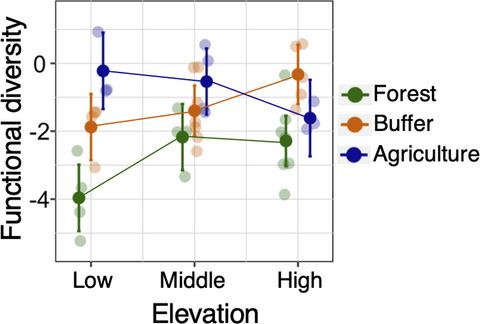当前位置:
X-MOL 学术
›
J. Appl. Ecol.
›
论文详情
Our official English website, www.x-mol.net, welcomes your
feedback! (Note: you will need to create a separate account there.)
Land use and elevation interact to shape bird functional and phylogenetic diversity and structure: Implications for designing optimal agriculture landscapes
Journal of Applied Ecology ( IF 5.0 ) Pub Date : 2021-05-22 , DOI: 10.1111/1365-2664.13927 Rachakonda Sreekar 1, 2 , Xingfeng Si 3 , Katerina Sam 1, 4 , Jiajia Liu 5 , Salindra Dayananda 6, 7 , Uromi Goodale 6, 8, 9 , Sarath Kotagama 7 , Eben Goodale 6
中文翻译:

土地利用和海拔相互作用塑造鸟类功能和系统发育多样性和结构:对设计最佳农业景观的影响
更新日期:2021-05-22
Journal of Applied Ecology ( IF 5.0 ) Pub Date : 2021-05-22 , DOI: 10.1111/1365-2664.13927 Rachakonda Sreekar 1, 2 , Xingfeng Si 3 , Katerina Sam 1, 4 , Jiajia Liu 5 , Salindra Dayananda 6, 7 , Uromi Goodale 6, 8, 9 , Sarath Kotagama 7 , Eben Goodale 6
Affiliation

|
- The conversion of rainforests into agriculture resulted in massive changes in species diversity and community structure. Although the conservation of the remaining rainforests is of utmost importance, identifying and creating a biodiversity-friendly agriculture landscape is vital for preserving biodiversity and their functions.
- Biodiversity studies in agriculture have often been conducted at low elevations. In this study, we compared the functional diversity (FD), phylogenetic diversity (PD) and community structure of birds along an interacting gradient of land use (protected rainforest, reserve buffer and agriculture) and elevation (low, middle and high) in Sri Lanka. Then, we measured the compositional change by identifying how ecological traits (dietary guild, vertical strata, body mass and dispersal ability) and conservation characteristics (forest dependence and threatened status) responded to land use types.
- Elevation and land use interacted with each other to shape bird FD. Depending on the elevation, FD in agriculture was either higher or similar to forest. However, PD was similar across all elevation and land use types. Bird community structure in forest was functionally and phylogenetically clustered in comparison to agriculture. Insectivorous birds declined from forest to agriculture, and so did understorey and middle-storey birds. But frugivorous and canopy birds did not change across land use types, while nectarivores, granivores and carnivores proliferated in agriculture. Forests were dominated by birds with low dispersal abilities, but birds in agriculture had more evenly distributed dispersal abilities. About half of all the individuals in agriculture were composed of forest species, several of which were threatened.
- Synthesis and applications. Most farmers in Sri Lanka practice agriculture on small farms (c. 2 ha) and rely on services (e.g. pest control and pollination) provided by biodiversity for their livelihoods. Our results underline the important role of these heterogeneous agriculture landscapes in maintaining high functional diversity (FD) and harbouring several threatened species. While FD in agriculture was comparatively high, conservation decisions based on land use alone cannot be reliable, because land use effects were elevation dependent. Thus, priority setting exercises aimed at designing optimal agriculture landscapes should consider landscape features, in combination with elevation, to benefit both people and wildlife outside protected areas.
中文翻译:

土地利用和海拔相互作用塑造鸟类功能和系统发育多样性和结构:对设计最佳农业景观的影响
- 雨林向农业的转变导致物种多样性和群落结构发生巨大变化。尽管保护剩余的热带雨林至关重要,但识别和创造生物多样性友好型农业景观对于保护生物多样性及其功能至关重要。
- 农业生物多样性研究通常在低海拔地区进行。在这项研究中,我们比较了斯里兰卡在土地利用(受保护的热带雨林、保护区和农业)和海拔(低、中和高)的相互作用梯度上的鸟类的功能多样性(FD)、系统发育多样性(PD)和群落结构。兰卡。然后,我们通过确定生态特征(饮食行会、垂直地层、体重和扩散能力)和保护特征(森林依赖和受威胁状态)如何响应土地利用类型来测量组成变化。
- 高程和土地利用相互作用来塑造鸟类 FD。根据海拔的不同,农业中的 FD 要么更高,要么与森林相似。然而,所有海拔和土地利用类型的 PD 都相似。与农业相比,森林中的鸟类群落结构在功能上和系统发育上都是聚类的。食虫鸟类从森林减少到农业,下层和中层鸟类也是如此。但是食果类和冠层鸟类在不同的土地利用类型之间没有变化,而食蜜类、食谷类和食肉类则在农业中激增。森林以传播能力低的鸟类为主,而农业鸟类的传播能力分布更均匀。大约一半的农业个体由森林物种组成,其中一些受到威胁。
- 合成与应用。大多数农民在小农场(斯里兰卡实践农业Ç 2公顷),靠服务(如病虫害防治和授粉)生物多样性对他们的生计提供。我们的研究结果强调了这些异质农业景观在维持高功能多样性 (FD) 和庇护几种受威胁物种方面的重要作用。虽然农业的 FD 相对较高,但仅基于土地利用的保护决策并不可靠,因为土地利用的影响取决于海拔。因此,旨在设计最佳农业景观的优先事项设定工作应考虑景观特征,结合海拔,使保护区外的人和野生动物受益。









































 京公网安备 11010802027423号
京公网安备 11010802027423号